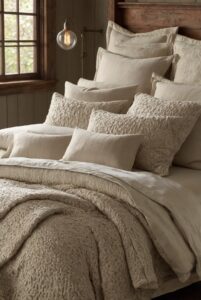Discover the importance of allergy-friendly bedding for a healthier bedroom environment. Explore essential interior designer tips for creating a soothing sleep space.
Benefits of using allergy-friendly bedding in the bedroom include:
– Reduced risk of allergies and respiratory issues
– Improved sleep quality and overall comfort
– Safe for people with sensitive skin
– Materials like hypoallergenic fabrics and dust mite-resistant materials
– Easy to clean and maintain
– Can enhance the aesthetics of the room
– Creates a healthier sleeping environment
– Ideal for individuals with asthma or eczema
Be sure to select bedding that is specifically designed for allergy prevention and follow care instructions to maximize the benefits. Consider incorporating allergy-friendly bedding as part of your home decor interior design for a comfortable and healthy living space.
Benefits of Using Allergy-Friendly Bedding in the Bedroom
Allergies can significantly impact our quality of life, especially when it comes to sleep. Allergy-friendly bedding can make a significant difference in creating a healthier environment in the bedroom. Here are some key benefits:
1. Improved Sleep Quality
Allergy-friendly bedding is designed to reduce exposure to allergens such as dust mites, pet dander, and pollen, which can trigger allergic reactions and disrupt sleep. By using bedding that is hypoallergenic and resistant to allergens, you can create a cleaner and safer sleeping environment, leading to improved sleep quality.
2. Reduced Allergy Symptoms
One of the most significant benefits of using allergy-friendly bedding is the reduction of allergy symptoms. Allergens present in traditional bedding can cause sneezing, coughing, itching, and congestion, making it difficult to relax and fall asleep. By switching to hypoallergenic bedding, you can minimize exposure to these allergens and experience a noticeable decrease in allergy symptoms.
3. Prevention of Asthma Attacks
For individuals with asthma, allergens in bedding can trigger asthma attacks and exacerbate respiratory symptoms. Allergy-friendly bedding can help prevent asthma attacks by creating a barrier against common allergens, reducing the risk of respiratory issues during sleep.
Additional Benefits of Allergy-Friendly Bedding
4. Skin Protection
Allergy-friendly bedding is often made from materials that are gentle on the skin and free of harsh chemicals. This can be particularly beneficial for individuals with sensitive skin or skin conditions such as eczema, as it helps reduce irritation and discomfort while sleeping.
5. Long-Term Cost Savings
While allergy-friendly bedding may have a slightly higher upfront cost compared to traditional bedding, the long-term benefits can result in cost savings. By investing in high-quality, durable bedding that is resistant to allergens, you can avoid frequent replacements and reduce healthcare expenses related to allergy symptoms.
In conclusion, using allergy-friendly bedding in the bedroom offers a range of benefits, including improved sleep quality, reduced allergy symptoms, prevention of asthma attacks, skin protection, and long-term cost savings. By prioritizing a clean and allergen-free sleep environment, you can enhance your overall well-being and enjoy a more restful and rejuvenating sleep experience.
1. How does allergy-friendly bedding help reduce allergies in the bedroom?
Allergy-friendly bedding is specifically designed to minimize allergens such as dust mites, pet dander, and pollen that can trigger allergic reactions. These bedding materials are made from hypoallergenic fabrics that are tightly woven to prevent the particles from penetrating the surface. By using allergy-friendly bedding, individuals can create a barrier between themselves and common allergens, resulting in a significant reduction in allergy symptoms such as sneezing, itching, and congestion. Studies have shown that utilizing allergy-friendly bedding can improve overall sleep quality and reduce the severity of allergies in the bedroom.
2. What are the key features of allergy-friendly bedding?
Allergy-friendly bedding typically consists of materials that are resistant to dust mites, mold, and other allergens. Some common features of allergy-friendly bedding include tightly woven fabrics, anti-microbial properties, and the use of natural fibers such as bamboo or silk. Additionally, many allergy-friendly bedding products are treated with hypoallergenic finishes to further reduce the risk of allergic reactions. These features help create a clean and safe sleeping environment for individuals who suffer from allergies, asthma, or other respiratory conditions.
3. Are there specific types of bedding that are more allergy-friendly?
Certain types of bedding are considered more allergy-friendly than others due to their natural properties and hypoallergenic qualities. For example, bamboo bedding is known for its anti-bacterial and anti-fungal properties, making it an excellent choice for individuals with allergies. Silk bedding is another popular option as it is naturally hypoallergenic and resistant to dust mites. Additionally, organic cotton bedding is a safe choice for allergy sufferers, as it is free from harsh chemicals and pesticides that can exacerbate allergies. Choosing bedding made from these materials can help individuals create a healthier sleep environment and reduce allergy symptoms.
4. How can individuals maintain their allergy-friendly bedding?
To maximize the benefits of allergy-friendly bedding, it is essential to maintain proper care and hygiene practices. Regularly washing bedding in hot water (above 130°F) can effectively kill dust mites and remove allergens. Using allergen-proof pillow and mattress covers can also help create an additional barrier against allergens. Vacuuming the bedroom regularly, reducing humidity levels, and avoiding clutter can further minimize allergen exposure. By following these maintenance tips, individuals can ensure that their allergy-friendly bedding remains effective in reducing allergy symptoms and promoting better sleep quality.
5. What other strategies can individuals implement to create an allergy-friendly bedroom?
In addition to using allergy-friendly bedding, there are several other strategies individuals can implement to create an allergy-friendly bedroom. Limiting the use of carpets and opting for hardwood or tile flooring can reduce the accumulation of dust mites and pet dander. Keeping windows closed during high pollen seasons and using air purifiers can help filter out allergens from the air. Washing curtains, rugs, and stuffed animals regularly can also prevent allergen buildup. By combining these strategies with allergy-friendly bedding, individuals can create a healthier and more comfortable sleep environment that promotes overall well-being.




